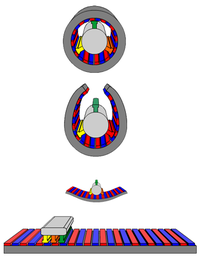
Photo from wikipedia
OBJECTIVE Upper limb function is a high priority for people with cervical spinal cord injury (SCI). This case report describes an application of technology to activate spared neural pathways and… Click to show full abstract
OBJECTIVE Upper limb function is a high priority for people with cervical spinal cord injury (SCI). This case report describes an application of technology to activate spared neural pathways and improve wrist motor control. CASE DESCRIPTION A 73-year-old man with chronic incomplete C5 SCI completed 24 training sessions over 92 days. Each session included 2 maximal contractions, 6 test trials, and 10 training trials of a visuomotor force tracking task. The participant attempted to match a sinusoidal target force curve, using isometric wrist flexor and extensor contractions. Electromyography (EMG) and force signals were recorded. OUTCOMES Errors were elevated initially and improved with training, similarly during extension and flexion phases of the force tracking task. Improvement in both phases was associated with greater flexor activation in flexion phases and greater extensor relaxation in flexion phases. Errors were not related to EMG modulation during the extensor phases. Small improvements in active range of motion, grip force, spasticity, touch sensation, and corticospinal excitability were also observed. CONCLUSIONS Motor skill training improved motor control after incomplete SCI, within the range of residual force production capacity. Performance gains were associated with specific adjustments in muscle activation and relaxation, and increased corticospinal excitability.
Journal Title: Physiotherapy theory and practice
Year Published: 2022
Link to full text (if available)
Share on Social Media: Sign Up to like & get
recommendations!